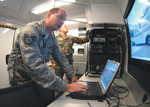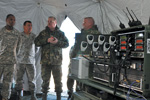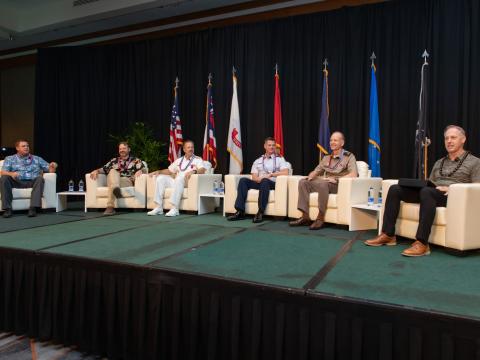Information Shared Is Power Squared
 |
Using a regional emergency response network, Tech. Sgt. Ray Simpson, USAF (l), and Staff Sgt. Bryan Detro, USAF, set up a communications link during relief operations in response to a tropical storm. To support these types of operations, the Universal Core (UCore) enables organizations from different services and agencies at least to glean "who, what, when and where" data from multiple databases. |
Four top-level federal organizations are taking a cue from the journalism handbook by focusing on the “who, what, when and where” to improve information sharing. Without developing new standards, this collaborative effort has created a federal information exchange specification and implementation profile that enables agencies to harvest the basics, regardless of where the data resides. Once fully embraced, this methodology, which still is in its infancy, holds great promise for addressing many of the information-sharing flaws identified by the 9/11 Commission and other assessments of the shortfalls in communications prior to the 2001 terrorist attacks.
Born from cooperation among the Department of Homeland Security (DHS), Department of Justice (DOJ), U.S. Defense Department and Office of the Director of National Intelligence (ODNI), the Universal Core (UCore) breaks down information-sharing barriers. It enables both federal and local agencies to glean top-level data from information located in a number of locations. UCore turns information-sharing methods on their heads by taking a minimalist approach to making data available to a broader audience of users.
While UCore is not a new standard, it allows software within hardware to see and to move data back and forth. The extensible markup language (XML) schema is the structured format that data needs to be in so that agencies’ computers know what information to look for and where to find it.
UCore enables government users to find just the fundamental information they need from a rich and extensive data environment. It focuses on commonly needed data points: Who is it? What is it? Where is it? When was it there? It employs system independent language and operates across organizations. In addition, it accommodates legacy systems to support interoperability and to ensure the greatest potential for information sharing. It also features common rather than unique security labels.
The framework defines an implementable specification that contains agreed-upon representations for the most commonly shared and universally understood concepts, boiling down data so that users can grab the who, what, when or where information that they need. It works on the machine-to-machine level, overcoming the information-sharing hurdle created by data stovepipes and incompatible systems. To accomplish these tasks, UCore addresses the challenges posed by tailored formats, point-to-point connections and human error introduced when data is entered manually.
According to Clay Robinson, chief of data strategy, enterprises services and integration, Chief Information Office, Defense Department, representatives from each of the four founding organizations drew upon the National Information Exchange Model (NIEM) as a framework and a standard when developing the UCore concept. However, they agreed that a new approach to information sharing would not be feasible if it involved finding a way that the thousands of terms the NIEM comprises could be used in every possible application. “We came up with the concept that if we could have a common approach when it comes to interoperability for the terms that relate to who, what, where and when, we would be significantly further along [in sharing information],” Robinson says.
“We have so much content out there that is not being shared in many places that could bring the full value to the government. When I see something like UCore, I just see a lot of opportunity. We are not creating something new, we did not come out with some new standard, and we are not asking people to change what’s inside their legacy systems that have been around for a while,” he adds.
Work on the UCore project began last year as one approach to addressing the breakdowns in communication identified by the 9/11 Commission and the current state of data sharing among government agencies. “Some people here go back and look at the 9/11 Commission Report, and they talk about what a poor job we’ve done of sharing all of that content and data assets that are out there. Certainly there are some people who have little nuggets of value from things that are out there, but having visibility and accessibility across all of that content is just not working well,” he states.
To help solve this problem, the Office of the Assistant Secretary of Defense, Network Information and Integration (ASD NII), which also functions as the Defense Department chief information officer, determined that it would not be feasible to develop a single data model that could be applied across the military, homeland security and intelligence communities. In fact, even developing an effective overall data model across any of the military services would be difficult, because they have different vocabularies when referring to the same items, Robinson allows.
To develop what resulted in the UCore concept, the ASD NII first began to work closely with the intelligence community and the ODNI to create a common approach for allowing access to the most common data bits that would benefit a multitude of communities of interest. Initially, the two organizations developed UCore 1.0, and some groups began to use it. However, the ASD NII and the ODNI realized that the same information that these groups were sharing could be valuable to other government organizations.
At that point, the two organizations turned to the chief information offices of the DHS and the DOJ because they share an interest in many of the data assets, Robinson explains. Then, the four organizations began looking at the NIEM to further the UCore concept. “Unfortunately, in the standards arena, things do not happen instantly or overnight. But from where I’m sitting in the Office of the Secretary of Defense, we wanted something that applies across the total enterprise,” Robinson relates. “The idea was definitely not to create anything new in bringing these separate pieces together.”
 |
Joint Task Force Commander training course attendees learn about a National Guard capability that creates a communications bridge between first responders and federal, state and local agencies within an hour of arriving at the scene of an emergency. Information that resides in other organizations can be made available through UCore. |
Introducing the UCore beta version that communities of interest could explore was the next step. Because of the different vocabularies various government organizations use, it would be impossible to add a new data model that could be applied across all of the communities. So instead, UCore offers a common way to exchange the “who, what, when and where” data bits. “[This information] may reside in our applications, programs, systems or platforms in a lot of different formats. But when we move it across—from an interoperability standpoint—if we can exchange it, then that’s great,” he notes.
UCore is context independent, Robinson emphasizes, which means that it does not matter if the data has been collected by a government agency or nongovernmental organization. In addition, the four organizations decided that information must be extensible, he states. The UCore high-level framework means that communities may have significantly more data at the lower levels, but some general information can be broadly used.
For example, full-motion video collected by a Predator unmanned aerial vehicle may have more than 50 elements in the imagery standards profile. Analysts who dig into details require all of those elements; however, personnel within other organizations may need to know only where imagery was captured. UCore allows these organizations to pluck this specific information from the imagery.
Another key feature of UCore is that it includes a common way to address security labels and markings. The classifications of secret, top secret, unclassified and confidential are addressed universally not only across a particular military service or the Defense Department but also across the federal government.
To achieve this level of security, UCore employs the intelligence community information security markup (IC ISM) standard, Robinson explains. Defense Department discovery metadata also is applied. By having IC ISM as part of UCore within the message framework, a computer knows what to look for across the Defense Department, intelligence community, DHS and DOJ, he adds.
Because there are many different message formats from sensor feeds between platforms, the data moves within a message framework called the universal law enforcement exchange. It is derived from the broader NIEM and is a message framework that is used among DOJ entities, including the Federal Bureau of Investigation, as well as by state and local law enforcement organizations.
UCore also takes into account what the team calls unanticipated users. The ASD NII believes this is an area where government agencies are missing much of the extra value of available data. For example, information about facilities in a geographic location is useful to facilities engineers, but it also could be used during an emergency situation by first responders, Robinson explains.
“We think that the unanticipated user has got to be planned for. … There may be times when we collect data for a narrow, specific community, so we will set up a portal. We say if you want this data, just go ahead and type in your login and password, not thinking about the multitudes of others who could use it if they were aware that it exists. And I did not exclude those other people just to exclude them, but I never thought of them. I’ve run into those circumstances,” Robinson notes.
Particular attention has been paid to privacy act laws and intelligence concerns, he stresses. On the other hand, if data already has been collected as a result of official security activities, it can be shared to benefit government personnel in specific locations during emergency situations. Wildfires are one example of how information gathered by the military could help first responders. If data is UCore compliant and at least some cell towers remain operational, firefighters could access maps that reside on a government server through wireless devices.
Pilot projects concluded in September 2008, and the UCore executive steering council, which comprises representatives from each of the four founding organizations, decided to wait until the spring of 2009 to move forward. On March 30, 2009, the council approved UCore version 2.0. At first, access was limited to government agencies; however, it has since been opened to other potential partners, and more than 1,000 users have registered through the site.
“We think that there is tremendous value to folks in the commercial sector to embrace UCore because it will help them then assert that they are contributing to improving the information-sharing situation across the government,” Robinson states. He recommends that companies familiarize themselves with UCore so that they can use this information when they write proposals or present solutions to government agencies.
“A lot of us grew up taught that information is power. So if I have information and you can only come to me for it, then that makes me more powerful. When I’m giving a presentation, I get the audience caught up in that [viewpoint], and they say, ‘Yes, we know what you are talking about.’ And then I look at the audience and say, ‘But information shared is power squared.’ Maybe more people are relying on it, and they realize that it’s coming from me,” Robinson states.
WEB RESOURCES
Universal Core (UCore): www.defenselink.mil/cio-nii/initiatives/ucore.shtml
UCore login: https://www.ucore.gov/ucore


Comment
I have been following UCORE
Agree with you totally! In
Comments